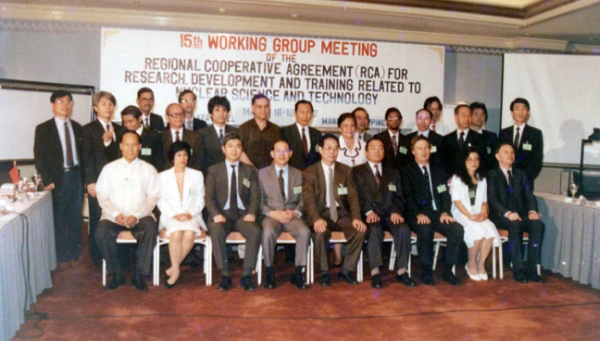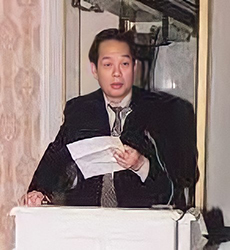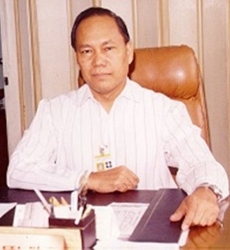History

















Management
A transformation in the RCA management structure took place during this decade. The 18th RCA Working Group Meeting (RCA WGM) held in 1996 in the Peoples’ Republic of China, appointed a Working Group to “Review the Management Structure of the RCA Programme and Develop Proposals for the Future”. National RCA Coordinators of Indonesia, Japan, Malaysia, New Zealand, Pakistan, the Philippines, and Sri Lanka were members of the Working Group, which was chaired by Dr. John Rolland, the National RCA Coordinator of Australia. Two of the Working Group members, Dr. Carlito Aleta (The Philippines) and Dr. Prinath Dias (Sri Lanka), later served as IAEA RCA Coordinators.
The Working Group met in Vienna on 11-13 September 1996, and its report was presented to the 19th RCA WGM held in March 1997 in Myanmar. The specific issues discussed were a) mechanism for new project proposals b) project review and reporting c) RCA WGMs, RCA GCMs, and the RCA Annual Reports d) project implementation e) IAEA-RCA interaction, and f) increased regional management and coordination. The Working Group made 12 recommendations. Some of the more notable recommendations are given below.
It was recommended that in the future, only a Member State (i.e., an RCA Government Party) should be able to table a new project proposal. It was also recommended that the National Coordinators Meetings for each project assume the responsibilities of the Project Committee, as set out in Article VI of the RCA Agreement, and that the focus of the RCA WGMs should be on policy issues rather than the review of RCA projects. Another recommendation was on improving coordination to avoid duplication of RCA and non-RCA regional projects. The Working Group also recommended the development of a mechanism for implementation of regional activities by RCA Member States (i.e., Government Parties). Commencement of RCA projects fully funded by the Member States, or a non-Agency source at any time within the biennial programming cycle was also a recommendation. Another recommendation was on stationing a senior RCA Representative in the region by January 2000.
The first RCA Guidelines and Operating Rules (GOR) were adopted during this period (RCA GCM of 1997). Other developments that took place during this period include the introduction of Lead Country Coordinators (LCCs) and Regional Resource Units (RRUs) to the RCA Programme. There were some changes in the terminology as well, to improve alignment with the RCA Agreement of 1987. The RCA National Coordinators were renamed RCA National Representatives and RCA Working Group Meetings (WGMs) were renamed Regional Meetings of RCA National Representatives. (RCA NRMs)
The Regional Cooperative Agreement of 1987 was extended to another 5 years in 1992 and in 1997.

Government Parties
New Zealand (1997) and Myanmar (1998) became parties to the RCA during this period, increasing the number of Government Parties to 17.
Projects
Forty seven RCA Projects implemented under the Technical Cooperation Programme of the IAEA were initiated during this period, comprising 8 projects on agriculture, 5 on environment, 4 on energy planning, 14 projects on industry, and 7 projects on human health. There were also 4 projects on radiation protection, 2 on research reactors, 2 on development of TCDC, and one project on nuclear information.
The agricultural projects were on food irradiation, plant breeding, animal production and health, and soil fertility. The environmental projects were on assessment of air pollution, management of marine pollution, management of drinking water sources, investigation of geothermal energy sources, and dam safety. The projects on energy planning were related to comparative assessment of electricity generation options, options for mitigating greenhouse gas emissions and planning for nuclear power. The focus of the projects on human health was in areas of nuclear medicine, quality assurance in radiotherapy and sterilization of tissue grafts, and LDR and HDR brachytherapy. Two projects on distance learning in nuclear medicine and radiation oncology were also initiated during this period. The focus of the projects on industry continued to be tracer technology, non-destructive testing, radiation processing, and nucleonic control systems. The projects in radiation protection were on harmonization of practices, environmental monitoring, and disposal of radioactive waste from non-power applications. The projects on research reactors were focused on improving their operation and utilization.
30 projects, including projects that were initiated during the previous decade, were completed during this period.
RCA Chairpersons
Dr. Masanori Wada (Japan), Dr. Carlito Aleta (The Philippines), Professor A. Djaloei (Indonesa), Dr. Ahmad Sobri Haji Hashim (Malaysia), Dr. Li Donghui (Peoples’ Republic of China), Dr. Tin Fflaing (Myanmar), Dr. Peter Roberts (New Zealand), Dr. Tan Teng Huat (Singapore), Dr. A.K. Anand (India), and Prof. Naiyyum Choudhury (Bangladesh), served as RCA Chairpersons during this period
IAEA Personnel



the 25th Anniversary of the RCA in 1997
Dr. John Easey (1990-1995), Dr. K. Yanagisawa (1996-1997), and Dr. Carlito Aleta (1997-2003) functioned as RCA Coordinators during this period. In between the appointment of RCA Coordinators, the Section Heads of former East Asia and Pacific Section, Dr. Javed Alsam (November 1995 - March 1996) and Dr. M.N. Razely (March - July 1996) and Director, TC Division for Africa and Asia, Dr. P.M. Baretto assisted by Dr. Alexander Rogov (June - November 1997), served as RCA Coordinators in acting capacities. Dr. Qian Jihui was the Deputy Director General and the Head of the Department of Technical Cooperation during this period.


